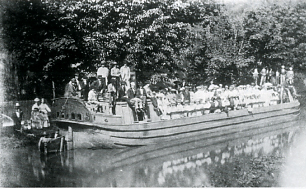
Click Here to Return to Milestones
Many years ago in Beaver County, the late Colonel
James P. Leaf began to think of a canal. He was a prime mover
in the canal business of modern times. Beaver County today still
is being peppered with canal projects-pro and con.
Canals enjoyed a huge role in the development of Pennsylvania and Beaver County in the years gone by. Private companies undertook to build and maintain canals between 1790 and 181.6. (Beaver County was erected in 1800).

The state began construction of this type of
waterway from Pittsburgh and Philadelphia and to Lake Erie back
in 1826. More than 600 miles of canals and "feeders"
were constructed.
One of the most famous routes of travel in that day was the old
canal route from east to west with the portage railroad over the
Allegheny mountains. This over-the-hump railway was 37 miles in
length,
On March 21, 1831, Governor Wolf signed a bill appropriating $100,000
to build a canal from the mouth of the Beaver River to New Castle.
This move brought howls of derision from interests in the eastern
part of the state. The gentlemen who received most of the credit
for the project were General Samuel Power and Hon. John R. Shannon,
then county representatives, and Hon. Moses Sullivan, Butler County,
state senator of the Beaver-Butler District.
John Dickey was superintendent of the Beaver
Division of this canal. On April 15, 1831, he gave notice that
bids would be received up to July 20, 1831 (at sunset,) for construction
"Of a canal or slackwater navigation from the mouth of the
Big Beaver to New Castle." The contract included dams, locks,
bridges, sections, and towing-paths. Some 73 firms and individuals
nabbed portions of the contract.
In a beautiful grove opposite Fallston, on July 26, 1831, there
was held a great canal celebration -a ground-breaking ceremony
marking the start of tile Beaver Section of the Pennsylvania Canal.
Big shots on the program for that day were: Major Robert Darragh,
president; M. F. Champlin, chief marshal; and Major B. G. Goll,
assistant.
The actual ground-breaking was done by soldiers of the Revolutionary
war. These vets were there with plows, shovels, picks, and oxen.
There was the firing of cannon and, of course, tumultuous shouting.
Among the Revolutionary survivors present were Lieutenant James
Moore, Nate Coburn, and Henry Woods.
After the groud-breaking, a big feed was enjoyed in the grove.
John Dickey, Esq. was speechmaker of the day. After his speech,
toasts were proposed (The toasts were after the custom of that
day.) It is recorded that there were 16 regular and 28 voluntary
toasts. (Whew!) The last of the voluntary toasts were given by
Representatives Sam Power and John Shannon. The old Western Argus
reported that: "Mr. Shannon responded to this toast in a
neat, concise and comprehensive address, and in most felicitous
language."
Actual cost of this waterway was much more than was estimated.
In fact it was $500,000 more than the estimate, and the time of
completion, too, got away. Some writers say it was more than a
year later than estimated; others say "several."
Well, anyway, the old canal served its purpose.
It put Beaver County on the map. The canal was sold, and the Harmony
Society became owner of the title to the canal bed, the dams and
the towpath from the south end of New Brighton to the mouth of
the Connoquenessing Creek at Rock Point.
I might mention here that Bausman, noted Beaver County historian,
wrote in 1904 that:
"But this means of transportation
will yet play an important role in western Pennsylvania, if the
future shall bring the fulfillment of the hopes which have been
entertained for the building of the Lake Erie and Ohio River ship
canal. Some history has already been made in this enterprise.
The initial step toward it was taken when the legislature of Pennsylvania
in 1889 authorized the appointment of a commission to make a survey
for a ship canal to connect the Ohio River with Lake Erie, and
appropriated $10,000 for that purpose."
Hartford Brown of Rochester introduced the bill to which Mr. Bausman refers. W. S. Shallenberger was a member of the first commission appointed to report on this project.